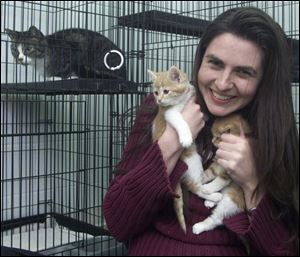
Advocate campaigns for safety net for dogs, cats
11/11/2002
`The big start was just getting ... all the animal welfare organizations onto the same page,' says Aimee St. Arnaud, who works for the Best Friends Animal Sanctuary.
They're fluffy, big-eyed, cuddly, adorable. Kittens, cats, puppies, dogs, tail-wagging, stalwart friends and guardians.
There are just too many of them.
Pat Lenahan helps run the Paws and Whiskers Cat Shelter. “People are dumping off cats all the time until we're out of cages,” she said. “Sometimes we get up to 35 calls a day, and one or two adoptions. We have 70 cats on any given day. It's overwhelming, and I really don't know what happens to the ones we have to turn away.”
Aimee St. Arnaud, a Toledo native who lives in Perrysburg, can't stand the thought of so many unwanted-but-healthy dogs and cats being euthanized.
So she works.
Ms. St. Arnaud works for the Best Friends Animal Sanctuary, an advocacy group in Utah that oversees the No More Homeless Pets program. Here in Toledo, that translates to coalition-building and cat-fixing, she said.
“The big start was just getting together with all the animal welfare organizations and getting everyone onto the same page,” she explained. “There have been some differences between them in the past, but we share a goal: a world where every puppy or kitten born is assured a good home, and no healthy animal is ever killed for lack of a home.”
Toledo has its share of animal-loving organizations. The county dog warden takes in stray dogs, but not cats. The Toledo Area Humane Society takes in dogs and unwanted pet cats, but not stray cats. There's Lend-A-Paw, Planned Pethood, Save-A-Pet, and Paws-And-Whiskers, all with their own programs, agendas, and ideals.
Sometimes, they got along like cats and dogs.
Nowadays, they list the animals in their care whisker to jowl on a shared Web site. When time runs out for hounds on the dog warden's death row, one of the no-kill shelters is contacted to pick up the unchosen pets. The animals are distributed among whatever openings exist in the network, so they have another chance.
In the first year of its operation, the program saved more than 500 pooches from the final hypodermic, Ms. St. Arnaud said. And with help from an area veterinary school, all animals adopted from the warden will now receive free spay and neuter surgery.
Ms. St. Arnaud, 30, is nothing new to local animal agencies. She's been a volunteer and foster home for the Toledo Humane Society since she was a teen and worked a year as their special events and education coordinator. Last year, she heard the Sanctuary needed a representative, so she took a job setting up networks of animal shelters throughout the country.
Just to get started, she threw a convention in Columbus a year ago for people who run shelters.
“I wasn't sure how that would work, because a lot of people get into this because they like animals better than people,” she said. “But 172 people came, we had national speakers, and I stayed in touch with a lot of them. I help people start No More Homeless Pets programs. That means helping them find funding, build coalitions, start spay-neuter programs and adoption programs.”
She founded Humane Ohio, a last-chance program for all kinds of animals from all over the state.
And with $25,000 in City of Toledo Department of Neighborhoods money and matching private donations, she helped organize Project Felix, a pilot program designed to deal with the city's rising tide of stray cats.
With information gathered from neighbors, police, and social service agencies, Project Felix rounds up cats and kittens in several low-income city neighborhoods for a monthly “Spay Day,” Ms. Arnaud said. Some are feral, some are pets whose owners can't afford the usual $40 to $100 fee charged to alter a tom or a kitty and eliminate next year's litter.
The work requires about 50 volunteers, she said, people from the area Veterinarians Association, the Stautzenberger College veterinary program, and an array of rescue groups. The cats are brought to the Toledo Public Schools' Natural Sciences Technical Center for their treatment, and high school students studying animal care can help the newly altered cats recover before they go home.
Similar programs exist in Columbus, Cleveland, and Dayton, she said.
“This is crucial work,” Ms. St. Arnaud said. “So far, we've fixed 200 cats. Our goal is to do 800 by June, and eventually expand it through the city. We think people will start noticing a real difference by a year from now. Eventually we want every animal in Lucas County to have a lap to sit in.”